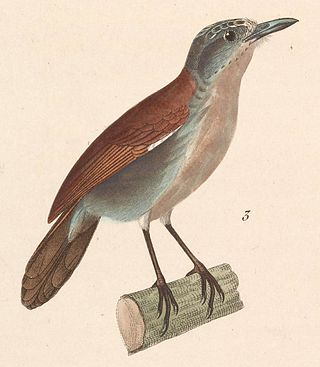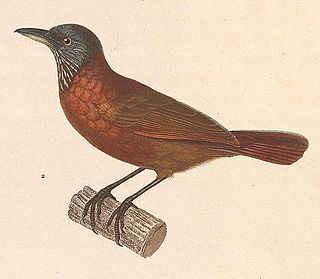The Naung Mung scimitar babbler is a bird in the family Pellorneidae, described as new to science in 2005. It is sometimes considered conspecific with the closely related short-tailed scimitar babbler.

The malia is a medium-sized babbler-like passerine. It has an olive-green plumage, yellowish head and chest, and pinkish-brown bill. The young is duller than the adult. It is the only member of the genus Malia.

The fluffy-backed tit-babbler is a species of bird in the family Timaliidae. It is found in Brunei, Indonesia, Malaysia, and Thailand. Its natural habitats are subtropical or tropical moist lowland forest and subtropical or tropical swampland. It is threatened by habitat loss.

The brown tit-babbler is a species of bird in the family Timaliidae. It is endemic to the Philippines. Its natural habitats are subtropical or tropical moist lowland forest and subtropical or tropical moist montane forest.

The large scimitar babbler is a species of bird in the family Timaliidae. It is found in Bangladesh, Cambodia, China, India, Laos, Malaysia, Myanmar, Thailand, and Vietnam. Its natural habitats are subtropical or tropical moist lowland forest and subtropical or tropical moist montane forest.

The Javan scimitar babbler is a species of bird in the family Timaliidae. It is endemic to Java, Indonesia. The Sunda scimitar babbler, which is found in Sumatra, Borneo, and Malaysia, was formerly considered conspecific, with both species being grouped as the chestnut-backed scimitar babbler. Its natural habitats are subtropical or tropical moist lowland forest and subtropical or tropical moist montane forest.

The streak-breasted scimitar babbler is a species of bird in the family Timaliidae.

The pied shrike-babbler is a bird species traditionally considered an aberrant Old World babbler and placed in the family Timaliidae. But as it seems, it belongs to an Asian offshoot of the American vireos and may well belong in the Vireonidae. Indeed, since long it was noted that their habits resemble those of vireos, but this was believed to be the result of convergent evolution.

The shrike-babblers are a group of small birds in the genus Pteruthius. They are native to the Indomalayan realm, and were traditionally placed in the family Timaliidae before molecular phylogenetic studies in 2007 found that they were best considered as belonging to the family Vireonidae which was then thought to be restricted to the New World. They were traditionally classified into five species with several subspecies but changes in the status of these species on the basis of the phylogenetic species concept suggest more forms in a cryptic species complex. Most species are found in montane forests, with some species descending down to lower altitudes during the winter.

The black-eared shrike-babbler is a bird species in the vireo family, Vireonidae. It was traditionally considered as an aberrant Old World babbler and formerly placed in the family Timaliidae. It was long noted that their habits resembled those of vireos, but this was previously ascribed to the result of convergent evolution. It is found in Southeast Asia from the Himalayas to western Malaysia. Its natural habitat is subtropical or tropical moist montane forests.

The green shrike-babbler is a bird species that was earlier placed in the family Timaliidae. The species is now considered to be an Asian offshoot of the American vireos and belongs in the family Vireonidae.

The white-breasted babbler is a species of bird in the family Timaliidae. It is endemic to the island of Java in Indonesia. Most records are from West Java.

The grey-headed babbler is a species of bird in the family Timaliidae. It is found in Brunei, Indonesia, Malaysia, and Thailand. Its natural habitat is subtropical or tropical moist lowland forest.

The white-bibbed babbler is a species of bird in the family Timaliidae. It is found in Bali and Java.

The white-bellied erpornis or simply erpornis is a species of bird. It is the only member of the genus Erpornis. This bird is found in Bangladesh, Bhutan, Brunei, Cambodia, China, India, Indonesia, Laos, Malaysia, Myanmar, Nepal, Singapore, Taiwan, Thailand, and Vietnam. Its natural habitat is subtropical or tropical moist montane forests.

The Taiwan scimitar babbler is a bird in the family Timaliidae, the Old World babblers. It is endemic to Taiwan. The species was first described by Robert Swinhoe in 1859. It was formerly treated as a subspecies of the streak-breasted scimitar babbler. Its population is declining, but not rapidly enough for it to be considered vulnerable.

The clicking shrike-babbler is a species of bird in the family Vireonidae. It is found from Assam, India, eastern Myanmar to southern China, and southern Vietnam. Its natural habitats are subtropical or tropical moist lowland forests and subtropical or tropical moist montane forests. It used to be considered a subspecies of the chestnut-fronted shrike-babbler.

The trilling shrike-babbler is a species of bird in the family Vireonidae. It is endemic to the island of Java. Its natural habitats are subtropical or tropical moist lowland forests and subtropical or tropical moist montane forests. It used to be considered the nominate subspecies of the chestnut-fronted shrike-babbler.

The Himalayan shrike-babbler is a bird subspecies found in the western Himalayas that belongs to the shrike-babbler group. The genus was once considered to be an aberrant Old World babbler and placed in the family Timaliidae until molecular phylogenetic studies showed them to be closely related to the vireos of the New World, leading to their addition in the family Vireonidae. Males and females have distinctive plumages, with the males being all black about with a cinnamon-rufous tertial patch and a distinctive white stripe running from behind the eye. The underside is whitish with some pinkish buff on the flanks. Females have a greyish head, lack the white stripe and have the upperparts and wings with greens, yellow and chestnut. The subspecies is part of a cryptic species complex that was earlier considered as one species, white-browed shrike-babbler with several subspecies.

The Dalat shrike-babbler is a bird subspecies traditionally considered an aberrant Old World babbler and placed in the family Timaliidae. But as it seems, it belongs to an Asian offshoot of the American vireos and may well belong in the Vireonidae. Indeed, since long it was noted that their habits resemble those of vireos, but this was believed to be the result of convergent evolution.





















